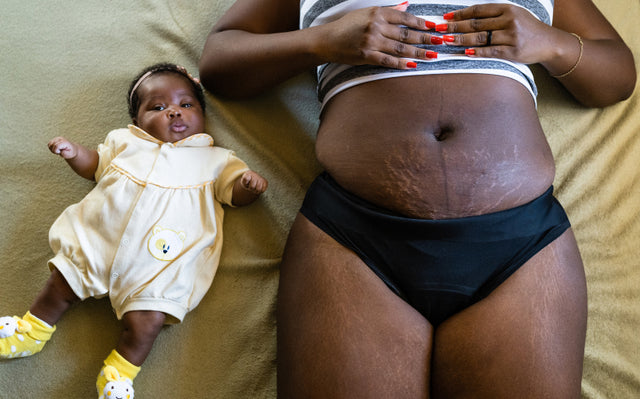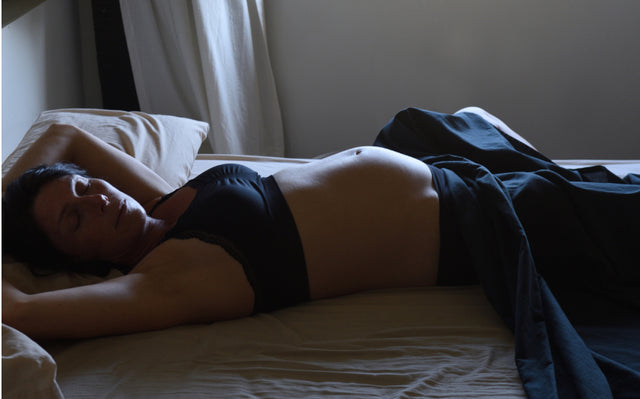Midwives & postpartum doulas break down exactly what to expect from your body after birth
Your postpartum body...might not be quite what you expected. You’re not alone here. We chatted with midwives Karen Fiebig and Holly Smith, naturopath and doula Claire Eden and registered nurse Georgia Avery to help you prepare for your postpartum journey – blood clots, boobs, baby blues, first poos...and all.
What are the ‘baby blues’ people talk about in the first week after birth? Does it happen to everyone?
Karen: The baby blues are a completely normal part of being a new mum. We usually see it happen around days three to five after birth, which may coincide with the woman’s milk ‘coming in’. It’s caused by the swings in a new mum’s hormones, which can make her feel very teary, anxious, overwhelmed and out of balance. Lack of sleep can make a woman feel slow, tired and down. She may question whether she has what it takes to look after her new baby. When the hormones start to settle, most mums find their groove and it gets a little easier each week. While newborns are tough, I’ve found women are tougher.
And while it doesn’t happen to everybody, it happens to most mums in varying degrees. It should only last a few days, so if the feelings are prolonged over a few weeks, or getting worse, it’s important for mums to speak up and ask for help from your GP to ensure you’re not suffering from postnatal depression.
Claire: The ‘baby blues’ affect up to 80% of people after birth and are widely believed to be caused by the sudden drop in levels of oestrogen and progesterone immediately after birth. As these hormones drop, prolactin kicks in and rises significantly to trigger lactation. For some people the day their milk comes in is the "bluest" feeling day. It’s normal to feel emotional and overwhelmed during this time, but cuddling and feeding your baby can often help bring you back into balance.
If these feelings continue beyond the first two to three weeks and develop into feelings of hopelessness, anxiety and overwhelm, or you’re noticing signs such as not wanting to shower or take your of yourself, not wanting to eat or drink, continually checking on your baby or not wanting to leave baby with anyone else, please ask family and friends for help with day-to-day tasks so you can rest and speak to your health care provider or reach out to a support network such as PANDA for advice.
For help & support with depression and anxiety during pregnancy and postpartum, contact Perinatal Depression & Anxiety Australia (PANDA) on 1300 726 306.

What will happen to my breasts?
Georgia: It is common for women to experience darkened and enlarged nipples during pregnancy and postpartum, caused by the same hyperpigmentation which causes the Linea Nigra.
If you’re breastfeeding:
Karen: Normally a woman will start to feel breast changes anywhere from days two to five. Her breasts may feel hot, they will look ‘veiny’, they will be very heavy and will fill up with milk. She may feel like her boobs are big enough to feed every baby ever born! She may feel a little ‘off’ as her blood pressure can rise (plus the fact this is all happening on top of a huge lack of sleep!) With regular breastfeeding her breasts will settle down and feel more comfortable. It can take up to 6 weeks for a woman’s milk supply to establish so feeling uncomfortable with the size and feeling of her breasts is completely normal.
Claire: It’s normal for your breasts not to feel full immediately after your baby is born, however bring baby to the breast as often as needed, remembering breastfeeding isn’t just for nutrition, but also for comfort. Breast milk production is a supply and demand relationship, meaning the more you bring the baby to the breast, the more milk your body will produce.
In the first few days after birth, your milk will transition from the first milk, called colostrum, which is a sticky, yellow consistency, to a more watery white milk. As your milk comes in, your breasts may feel engorged, tender and hot, feeding to demand during this time will help this pass more quickly, and skipping feeds or excessively pumping may lead to mastitis or over supply. Your breasts may leak between feeds and your opposite breast to the one feeding may leak during a feed. You can catch this excess milk with breast pads inside your bra – or try the new Modibodi Breastfeeding Bra or Breastfeeding Cami with built-in absorbency instead.
By week four your milk supply will generally have begun to settle, but it’s still normal to leak from the breast your baby is not feeding from for some.


Above: Modibodi Breastfeeding Bra or Modibodi Breastfeeding Cami
If you’re not breastfeeding:
Karen: If a woman is not breastfeeding, she may still experience some changes in her breasts. Her body knows she has had a baby and thinks it needs to make milk, so her breasts may still increase in size and start to feel heavy and hot. If she doesn’t put the baby to her breast and ‘ignores’ them, they should start to feel normal after a week or so, and her doctor or midwife can offer advice if she’s experiencing discomfort.
Claire: After birth, your hormones will tell your body to begin producing milk via the hormone prolactin regardless of whether you intend to breastfeed or not. Not feeding will stimulate the production of Prolactin Inhibiting Factor, which tells your body to shut down milk production. If your breasts feel sore and engorged, cabbage leaves or ice packs may help soothe the sensation, and by day 10 milk should be drying up and the feeling of fullness should have subsided. If not, talk to your healthcare provider about option to speed up the hormonal transition.
What will happen to my uterus/stomach?
Karen: A new mum’s stomach will probably look and feel like ‘jelly belly’ in the days after she has her baby, but within a couple of months (let’s not put pressure on anybody) she will start to not look pregnant anymore, she may fit back into her pre-pregnancy clothes and start to feel more like herself. Some women may notice permanent changes in the shape and size of their bodies, this is normal and nothing to be ashamed of.
A woman’s uterus will start to shrink immediately after giving birth. The top of her uterus will be palpable below her belly button within a couple of days after birth, but it isn’t usually back to normal size until about six weeks after delivery, although the speed of this change is different for everybody.
Claire: In the first week after your birth, your uterus will contract strongly to reduce its size and return to its pre-pregnancy position. Some people experience significant "after pains" for this first week. These may be worse with each subsequent pregnancy, and painkillers might be required to manage the pain.
Holly: The first thing to know is that your bump does not automatically go. Don’t be embarrassed or worried about your postnatal body, literally every single one is different. While your uterus will slowly return to its normal size over 6 weeks, we expect it to return to below your belly button on the first day, which is why we ask to feel your tummy after birth. Always let your midwife or doctor know if you experience pain in your stomach or uterus after birth. Your stomach will decrease back to a new normal over a few months, and some women choose to see a physio to help them re-build stomach muscle strength. you experience any pain in your stomach or uterus always let a midwife know.
Georgia: The Linea Nigra – the vertical strip which shows up on most pregnant women’s abdomens as a result of pregnancy hormones – will typically disappear between two weeks and two months’ after birth as your hormone levels return closer to their baseline.
If you’ve experienced stretch marks, like other scars, they’re unlikely to completely disappear, but they will probably change in colour and appearance over time. The colour usually fades and the scar ‘sinks’ back into the skin, making them less obvious with time. Tips to help lessen their appearance include avoiding excessive sun, regularly applying sunscreen and moisturising. If their appearance distresses you, there are prescription and surgical options available, so speak to your GP to find out your options.

Why do my hips feel wider now?
Georgia: Women often say their hips and pelvis feel ‘wider’ in the months after giving birth. This is due to a combination of physical weight and pressure changes, as well as the hormone ‘Relaxin’ which is released during pregnancy to soften and widen the cervix and relax your ligaments.
What happens to my vagina or C-section incision after birth?
If you’ve had a vaginal delivery:
Karen: Mums who’ve had a vaginal delivery may feel sore and swollen for a week, or more if you’ve had stitches, a tear or an episiotomy. For the best relief in the first 24 to 48 hours, combine regular pain relief (including an anti-inflammatory if appropriate) with icing your perineum at regular intervals. Hopefully, you’ll feel better as each day passes. Propping yourself on one side rather than sitting can help, or some women might like to use a haemorrhoid pillow or ‘donut’ cushion.
Claire: If you've had a vaginal birth, healing of the perineum can take anywhere from 2 weeks (no tearing or episiotomy) to six or more weeks with a tear or episiotomy. If you’ve had stitches, they may become itchy after the first week or so as they are beginning to heal. Your perineum may feel numb and/or swollen for the first week. Using a peri bottle with warm water when going to the toilet to urinate can help reduce stinging in the first weeks after birth.
Holly: Most women experience a tear that involves just their vagina and perineum (the part between your vagina and bottom), however some will have a more significant tear involving their bottom too. With any tear, caring for your stitches is important so always keep the area clean and dry. Most hospitals use dissolvable sutures which fall out over time, but it’s important to care for them by keeping the area clean and dry, but not to put soap directly onto your stitches. While it might seem scary, look at your stitches with a mirror. Most are internal and not actually visible, but by having a look you’ll know if the area is red or ‘angry’ or if there’s any oozing you should let your midwife or doctor know about. Stitches typically heal within 10 days and your doctor or midwife will check your perineum’s healing at your 6-week check after baby. And remember – don't put anything on your stitches, such as anti-bacterial cream, essential oils or aloe vera. Your vagina needs to be clean and dry to heal and adding other elements can upset the pH balance and cause infection.
Georgia: Some women experience some widening of the vagina after giving birth which is not surprising in the context of pushing a small human out of your vagina, but if you have ongoing concerns about these changes, always consult your doctor to investigate post-natal physiotherapy options. Hyperpigmentation of the vulva is also common.
If you’ve had a C-section:
Karen: A woman’s incision wound post c-section will be tender to start with and in the first few days she’ll probably walk slowly and need to take her time standing up. This is ok, remember, you’ve had abdominal surgery. As each day passes, the discomfort should decrease and you’ll be able to move more freely, although the wound itself will be sore to touch for the first couple of weeks, then start to feel better each day.
Some women may experience some numbness in the area around the incision, which will pass with time. The wound itself will change colour from pink to a light purple before becoming a thin scar low on your abdomen.
After a c-section, you shouldn’t lift anything heavier than your baby until your doctor tells you otherwise, and this includes heavy baskets of wet washing and lifting prams in and out of the car. As for driving, check with your car insurance provider for any specific timelines, and don’t attempt to drive until you can comfortably slam the breaks or twist to check your blindspot with ease.
Once you feel up to it, going for a nice walk each day with baby is a great idea, but avoid any physical sports or heavy gym workouts until you’ve been cleared by your doctor. Most importantly, give yourself permission to rest and recover – something most women are not good at!
Holly: When your baby is born by C-section your body has five layers which it needs to heal. This will take up to 6 weeks. During the first week you will notice that the line on your skin will heal first, and that laughing, coughing and bending can be uncomfortable. Some women have staples in their skin which will be removed by a midwife or doctor. Others will have dissolvable stiches which do not need to be removed. Keep your wound clean and dry. Use a separate towel when drying your wound to the rest of your body when you get out of the shower and avoid drying your pits and bits with the same towel as your scar. If you notice a red patch around your wound, feel unwell or notice puss tell a midwife straight away. Some women find feeding in an armchair is a good option to make it easier to get up and down.
When will I do my first poo – and how do I manage it if I have stitches?
Karen: The key to a successful first poo is preparation! Lots of water is imperative to keeping stools soft. If you’ve taken an opioid during labour or post-natally you may need a stool softener to avoid constipation. When sitting on the toilet, using a foot stool to bring your knees above your hips can help, and it’s important to relax and give yourself time to let the poo come down without pushing too hard. Placing your hand or a compress to support your perineum can also help make things more gentle. Remember, while the idea might seem scary, getting that first poo out is a wonderful feeling!
Claire: Most people are very daunted by the prospect of the first poo after birth, especially as it’s normal for the perineum to feel quite tender or numb, even if there aren't stitches. Besides staying hydrated, eating foods high in fibre can help reduce the risk of constipation. Holding a warm compress, like a face washer, can help you feel more secure in the early days after delivery.
Holly: Remember most women who have had stitches, won’t have them in or near their bottom, which means that while you might feel like your stitches are going to ‘burst’ or, as one woman told me, feel like ‘your vagina is going to fall out’ this won’t happen. Just remember to wipe from front to back like normal, don’t strain and use a compress to support the area if it helps you feel more comfortable. It’s also normal to not poo for a few days after birth, but plenty of fluids and fruit and veggies should help make the process stress-free. If you have a tear involving your bottom, your midwife or doctor will give you stool softeners and antibiotics. Stitches are very strong and it’s extremely uncommon for them to come apart.
How much bleeding is normal? Will I have blood clots?
Firstly, whether you have a vaginal or C-section delivery, there will be postpartum bleeding, and it’s completely normal.
Karen: During the first 24 hours after birth, a woman can expect to lose what will feel like a lot of blood, but this will be closely monitored by your midwife. Passing small clots during the first few days after delivery is not unusual, and occasionally a larger clot may pass. So long as everything settles down afterwards, this isn’t usually an issue. However, if you keep having heavy bleeding and passing clots, you should be reviewed by a doctor as this can be a sign of retained products, which means your placenta might not have completely come away from the uterine wall, or, if your blood loss or discharge has an offensive odour or weird colour, it could point to signs of infection.
Bleeding should continue to lighten each week, with spotting continuing for up to six weeks postpartum – Modibodi underwear is a great option throughout this time for everyday comfort.
Claire: During the first week the post-birth bleeding is typically dark red in colour, and if you’re passing clots larger than golf ball or soaking through your menstrual products more than every hour after the first 24 hours or so, talk to your healthcare provider. During the second and third weeks after birth, the initial heavy bleeding should begin to slow and change from dark red to a lighter pink or brown colour, with much less clotting. If you’re active, it’s normal to still have intermittent heavier bleeds, but they should slow again within 24 hours.
Holly: Some women notice that they pass small clots during or after a breast feed. This happens because the hormones produced when you feed your baby also cause your uterus to contract. If you’re unsure about your clots always talk to your midwife or doctor – photographing them can also help us know what’s normal. If you start feeling unwell because of heavy bleeding or clots, let your doctor or midwife know immediately or call an ambulance as this could indicate a postpartum haemorrhage which will need medical intervention.

Any red flags to look out for? Handy tips?
Karen: Always flag any signs of infection (odour, temperature, unusual bleeding or discharge) with a doctor and if you’re seeing signs of mastitis, seek medical attention quickly as you’ll need antibiotics to avoid becoming unwell (which makes it even harder to care for a new baby).
Your mental health is as important as your physical health and having someone on hand to help (family or friend) is a much-needed luxury if possible. Women don’t ask for this kind of help and support often enough, but we should, and it really does help.
Single mothers deserve so much credit, going through this huge change on your own… there aren’t enough words to describe the strength of these women.
And finally, if you’re on deck for meal preparation, cook dinner in the morning when you have the energy – a slow cooker will be your new best friend!
Disclaimer: Please note, Modibodi’s blog content is designed for educational and/or entertainment purposes, it is not official medical or healthcare advice. Please do not rely on this information as a substitute for professional medical advice, and always consult a doctor with any questions or concerns about your health.









